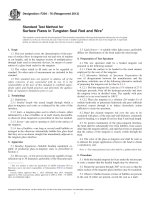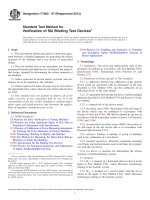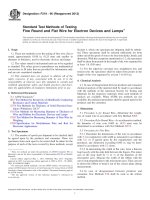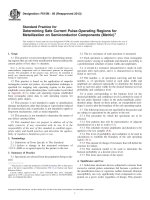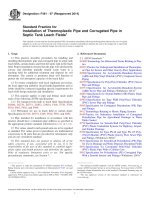Astm f 1841 97 (2013)
Bạn đang xem bản rút gọn của tài liệu. Xem và tải ngay bản đầy đủ của tài liệu tại đây (124.86 KB, 5 trang )
Designation: F1841 − 97 (Reapproved 2013)
Standard Practice for
Assessment of Hemolysis in Continuous Flow Blood
Pumps1
This standard is issued under the fixed designation F1841; the number immediately following the designation indicates the year of
original adoption or, in the case of revision, the year of last revision. A number in parentheses indicates the year of last reapproval. A
superscript epsilon (´) indicates an editorial change since the last revision or reapproval.
INTRODUCTION
The goal of blood pump development is to replace or supplement the function of the human heart.
As a result, continuous flow blood pumps, including roller pumps and centrifugal pumps, are
commonly used in clinical extracorporeal circulation. They are used not only for cardiopulmonary
bypass in routine cardiac surgery but also for ventricular assist, percutaneous cardiopulmonary
support, and extracorporeal membrane oxygenation.
Many investigators have attempted to develop an atraumatic blood pump. Hemolysis is one of the
most important parameters of blood trauma induced by blood pumps. However, comparative in vitro
evaluation of the reported results of hemolysis are difficult due to the lack of uniformity of the test
methods employed. Thus, it is necessary to standardize the method of performing in vitro hemolysis
tests for the evaluation of continuous flow blood pumps.
1. Scope
2. Referenced Documents
2.1 ASTM Standards:2
F1830 Practice for Selection of Blood for in vitro Evaluation
of Blood Pumps
1.1 This practice covers a protocol for the assessment of the
hemolytic properties of continuous flow blood pumps used in
extracorporeal or implantable circulatory assist. An assessment
is made based on the pump’s effects on the erythrocytes over
a certain period of time. For this assessment, a recirculation test
is performed with a pump for 6 h.
3. Terminology
3.1 Definitions:
3.1.1 continuous flow blood pump—a blood pump that
produces continuous blood flow due to its rotary motion.
3.1.2 free plasma hemoglobin—the amount of hemoglobin
(iron or heme-containing protein) in plasma.
3.1.3 hemolysis—damage to erythrocytes resulting in the
liberation of hemoglobin into the plasma.
3.1.4 Index of Hemolysis
3.1.4.1 normalized index of hemolysis—added grams of
plasma free hemoglobin per 100 L of blood pumped, corrected
for plasma volume using hematocrit and normalized by flow
rate and circulation time.
3.1.4.2 normalized milligram index of hemolysis—
normalized index of hemolysis expressed by milligram value
of free plasma hemoglobin.
1.2 The values stated in either SI units or inch-pound units
are to be regarded separately as standard. The values stated in
each system may not be exact equivalents; therefore, each
system shall be used independently of the other. Combining
values from the two systems may result in non-conformance
with the standard.
1.3 This standard does not purport to address all of the
safety concerns, if any, associated with its use. It is the
responsibility of the user of this standard to establish appropriate safety and health practices and determine the applicability of regulatory limitations prior to use.
1
This practice is under the jurisdiction of ASTM Committee F04 on Medical and
Surgical Materials and Devices and is the direct responsibility of Subcommittee
F04.30 onCardiovascular Standards.
Current edition approved March 1, 2013. Published March 2013. Originally
approved in 1997. Last previous edition approved in 2005 as F1841 – 97(2005).
DOI: 10.1520/F1841-97R13.
2
For referenced ASTM standards, visit the ASTM website, www.astm.org, or
contact ASTM Customer Service at For Annual Book of ASTM
Standards volume information, refer to the standard’s Document Summary page on
the ASTM website.
Copyright © ASTM International, 100 Barr Harbor Drive, PO Box C700, West Conshohocken, PA 19428-2959. United States
1
F1841 − 97 (2013)
used in the development stage of a pump, it is suggested that
pre-clinical evaluation tests be repeated with human blood.
3.1.4.3 modified index of hemolysis—mass of hemoglobin
released into plasma normalized by the total amount of
hemoglobin pumped through the loop.
5. Summary of Practice
4. Formulas
5.1 Blood—The blood is obtained from human volunteers,
cattle or pigs having normal body temperatures, no physical
signs of disease, including diarrhea or rhinorrhea, and an
acceptable range of hemotological profiles. The blood should
be collected by vascular puncture using a needle (14G or
larger) and collected into the standard 500–2000 mL bags
containing citrate phospate dextrose adenine (CPDA-1) anticoagulant solution (See Appendix X2) or heparin sulfate (See
Appendix X3). The blood from a slaughterhouse can typically
be used if it is obtained by controlled venipuncture.
4.1 Normalized Index of Hemolysis (N.I.H.) (1, 2, 3, 4)3:
N.I.H. g/100l 5 ∆freeHb 3 V 3
100 2 Ht
100
3
100
Q 3T
(1)
∆free Hb = increase of plasma free hemoglobin concentration (g/L) over the sampling time interval,
where:
V =
Q =
Ht =
T =
circuit volume (L),
flow rate (L/min),
hematocrit (%), and
sampling time interval (min).
5.2 Test Loop (4) (See Fig. 1)—The test loop consists of a
total of 6.6 ft [2 m] of 3/8 in. [9.5 mm] ID polyvinylchloride
tubing and a reservoir (typically, 13 by 13 cm) with a sampling
port. The primed blood volume is 450 6 45 mL. A screw
clamp, that is positioned at the outlet side, is applied to produce
the required conditions for the left heart assist application (5
L/min against 100 mm Hg pressure head (that is, with the
pressure sampling ports at the same vertical height, the
pressure in the outlet line of the pump is 100 mm Hg greater
than in the inlet line)) and for the cardiopulmonary bypass
application (5 L/min against 500 mm Hg pressure head).
(Optional testing at 350 or 700 mm Hg is also advisable.) To
monitor such pressure heads, the pressure monitoring lines are
incorporated into the test loop both at the inlet and outlet tubes.
An ultrasonic or electromagnetic flow probe is placed at the
outlet side of the pump between the clamp and the reservoir to
monitor the flow rate. A thermistor is connected to the loop,
and the blood temperature is measured using a corresponding
thermometer.
4.2 Normalized Milligram Index of Hemolysis. (mg.N.I.H.)
(2, 3, 4):
2mg.N.I.H.mg/100l 5 ∆freeHb 3 V 3
100 2 Ht
100
3
100
Q 3T
(2)
4.3 Modified Index of Hemolysis (M.I.H.):
4.3.1 Modified index of hemolysis (M.I.H.) (5, 6) that can
be written with no units or as (milligram of hemoglobin
released into plasma/mg of total hemoglobin pumped through
the loop):
M.I.H. 5 ∆freeHb 3 V 3
100 2 Ht
106
3
100
Q 3 T 3 Hb
(3)
where:
Hb
= total blood hemoglobin concentration at time
zero (mg/L), and
∆free Hb = increase of plasma free hemoglobin concentration (mg/L) over the sampling time interval.
5.3 Pump Conditions—Pump flow rate is set at 5 6 0.25
L/min at the circulating blood temperature of 37 6 1°C. The
total pressure head is set at 100 6 3 mm Hg for the left heart
assist application and 500 6 15 mm Hg for cardiopulmonary
bypass application. However, additional testing temperatures
can be chosen from 0 to 42°C according to the intended clinical
use of the pump (for example, cardiopulmonary bypass may
include cooling and warming during surgery.)
4.3.2 Among these indices, M.I.H. is recommended as an
index to express the degree of hemolysis caused by a blood
pump in a recirculating system. N.I.H. was proposed to account
for the plasma volume based on the hemotocrit. Recent
development of less hemolytic blood pumps has since made it
convenient to use mg. N.I.H. rather than N.I.H. However, both
the N.I.H. and the mg N.I.H. vary with hematocrit of the blood
(6). M.I.H. is the recommended index to express the degree of
hemolysis caused by a blood pump in a recirculating system.
The M.I.H. equation corrects for differences in blood hemoglobin concentration and hematocrit directly (5).
5.4 Evaluation—The free plasma hemoglobin is determined
by a clinically approved assay method (see 9.3). The free
plasma hemoglobin is standardized by calculating the M.I.H.
6. Significance and Use
4.4 Testing Blood—Because the level of trauma-induced
hemolysis is different based on the source of blood, it is
necessary to identify the source of blood and its respective
index of hemolysis. Human, bovine, or porcine blood are
recommended as the primary sources of testing blood (see
Practice F1830). It is preferable that the blood collected at a
standard slaughter house not be used due to the risk of being
contaminated with fluids other than blood, unless the blood is
obtained by controlled venipuncture. Although animal blood is
6.1 The objective of this practice is to standardize the
evaluation method for detecting the hemolytic effect of a
continuous flow blood pump used in extracorporeal circulation
and circulatory assistance.
7. Preparation of Hemolysis Test
7.1 Blood—The blood is obtained from human volunteers
having normal body temperature, exhibiting no physical signs
of disease and having hematological profiles in the normal
acceptable range. (Donors are subjected to standard blood
donor screening procedures.) The donor should be fasted for 8
3
The boldface numbers given in parentheses refer to a list of references at the
end of the text.
2
F1841 − 97 (2013)
FIG. 1 Test Loop
ological blood parameters should be maintained prior to and
during testing (for example, pH, base excess, glucose concentration).
h or more to avoid additional hemolysis due to a high
concentration of lipids in the blood. The delay in the collection
of the blood and the hemolysis test should not exceed 48 h of
refrigerated storage with the blood temperature kept between 2
and 8° C or more than 2 h at ambient condition. As an
alternative source of blood, animal blood can be used, but it is
necessary that the source of blood is identified. The preferred
animal blood is bovine and porcine (See Practice F1830). Since
the use of completely fasted animals is impractical, it is
recommended that the animals be subjected to a 12-h fasting.
As a quality control measure, any blood having free plasma
hemoglobin of more than 20 mg/dL should not be used for this
test. In order to standardize the blood trauma testing, the blood
subjected to the test should have the hematocrit value adjusted
to be within the range 30 6 2 % by hemodilution (with
phospate buffered saline) or hemoconcentration (via minimal
centrifugation). Proper and acceptable ranges of the physi-
7.2 Test Loop (See Fig. 1)—The closed test loop contains a
total of 6.6 ft [2 m] of 3/8 in. [9.5 mm] ID polyvinylchloride
tubing, a reservoir with a sampling port, an ultrasonic or
electromagnetic flow probe and its corresponding flowmeter, a
thermistor and its corresponding thermometer, and a blood
pump. The loop should be filled with phosphate buffered saline
that is recirculated for approximately 10 to 20 min to rinse and
wet all of the blood-contacting surfaces. The phosphate buffered saline is drained completely from the loop prior to filling
it with blood. After being washed with phosphate buffered
saline, the circuit is primed with 450 6 45 mL of fresh blood
into the reservoir bag. Air collected in the reservoir should be
eliminated and no air interface left in the reservoir. A screw
3
F1841 − 97 (2013)
8.4 The blood pump is started and adjusted at the flow rate
of 5 6 0.25 L/min.
clamp, that is applied to produce the required condition of
pressure head, is positioned at the outlet side of the pump. The
pressure monitoring lines are incorporated into the test loop
both at the inlet and outlet tubes. An ultrasonic or electromagnetic flow probe is placed at the outlet side of the pump
between the screw clamp and the reservoir to monitor the flow
rate.
8.5 The test duration recommended is 6 h, and one blood
sample is taken before pumping, and six blood samples are
taken at every hour of the test. This recommended sampling
schedule provides a sufficient number of test samples for
statistical evaluation. The free plasma hemoglobin is determined by a clinically accepted assay method. To ensure proper
samplings, gentle massaging of the reservoir and discarding 1
mL of the blood from the sampling ports are recommended
prior to blood sampling.
7.3 Pump Conditions—The flow meter should be calibrated
using blood at the proper hematocrit and temperature. The
pump revolution rate is adjusted to provide 5 6 0.25 L/min
flow rate as determined by the in-line flow meter, and all
experiments are conducted at a 37 6 1°C environment that is
achieved through submerging portions of the loop into a water
bath. However, additional tests conducted in temperatures
ranging from 0 to 42°C can be performed according to the
intended clinical use of the pump. Since all test runs are of a
6-h duration, sterility is generally considered not necessary.
8.6 For general testing, the circulating blood temperature
should be maintained at 37 6 1°C during the entire test
duration, although testing at other appropriate use temperatures
may be necessary.
9. Report
7.4 Evaluations—Blood samples of 1 to 2 mL (preferably 1
mL) are drawn from the reservoir before pumping and at every
hour of pumping. It would be preferable to withdraw at least
two blood samples at each sample time. At each sampling, the
first sample of 1 mL should be discarded because it may
contain blood that was stagnant in the sampling port. The
second sampling of 1 mL should be used for measurement of
plasma free hemoglobin. If the saline is drained completely
from the test loop prior to testing, the initial total blood
hemoglobin concentration, plasma hemoglobin concentration,
and hematocrit can be determined from the pre-pumping
control blood. Preferably, these time zero measurements are
obtained from blood that has circulated through the loop for
approximately 5 min to ensure complete mixing and dilution.
9.1 At first, the results should be reported as the time
dependent hemolysis data displayed graphically for each of the
five test devices and static blood controls. The regression
coefficient of these device plasma hemoglobin plots should be
greater than 0.95. Then, the report should be given in the form
of an index of hemolysis which is defined as milligram of
plasma free hemoglobin per 100 L blood pumped (mg N.I.H.)
and as an M.I.H. value.
9.2 At least five such tests should be conducted to confirm
the reproducibility of the tests. The individual index of
hemolysis values (both mg N.I.H. and M.I.H.) should be
reported for each of the five tests, along with the mean value 6
standard deviation. The designated index should be the highest
of the five tests.
7.5 Static Blood Controls—The control blood is kept in a
blood bag at the same temperature environment as that of the
testing blood. For sampling, the sampling procedures as those
for testing blood are required (see 8.5).
9.3 The clinically accepted assay methods are referred to in
the Appendix(7, 8).
8. Procedure
9.4 The modified index of hemolysis (M.I.H.) is recommended as the most appropriate measurement index in evaluating the degree of hemolysis caused by a blood pump in a
recirculating system. Although the mg NIH equation has been
typically used by researchers, it does not correct for differences
in hematocrit or hemoglobin content of the pumped blood (5,
6).
8.1 Figure 1 describes a standard closed loop for hemolysis
testing, that consists of the blood pump subjected to the test, a
reservoir with a sampling port, inlet and outlet tubings with a
pressure monitoring port at each segment of the tubing,
pressure transducers or a differencial pressure manometer, a
thermistor, and a flow probe. A screw clamp is also included in
this figure.
9.5 The blood donor source (for example human, bovine,
porcine) should be specified. Test temperature and pressure
head should also be reported.
8.2 The blood warmed to 37°C (or other appropriate temperature) should be infused by gravity into the test loop
through a sampling port of the blood bag.
10. Keywords
8.3 After the test loop is operated for approximately 5 min
and air bubbles are eliminated from the test loop through the
sampling port, the first blood sample is taken as the prepumping control.
10.1 blood pump; blood trauma; index of hemolysis; modified index of hemolysis (M.I.H.); normalized index of hemolysis (N.I.H.)
4
F1841 − 97 (2013)
APPENDIXES
(Nonmandatory Information)
X1. RATIONALE
X1.1 Even though blood trauma imposed on platelets and
leukocytes by blood pumps should be studied, the hemolysis
generated by a blood pump is the most significant blood
trauma. Thus, this practice was generated.
X2. CITRATE PHOSPHATE DEXTROSE ADENINE (CPDA) SOLUTION USP
X2.1 A CPDAI solution USP of 63 mL is added for
collection of 450 mL blood.
sodium phosphate (monohydrate) USP, and 17.3 mg adenine
USP.
X2.2 Each 63 mL of CPDAI contains 2 g of dextrose
(monohydrate) USP, 1.66 g sodium citrate (dihydrate) USP,
188 mg citric acid (anhydrous) USP, 140 mg monobasic
X2.3 The pH of the solution may have been adjusted with
sodium hydroxide.
X3. HEPARIN
X3.1 500 mL of blood containing 2000 to 3000 USP units of
heparin is utilized.
X4. CLINICALLY ACCEPTED ASSAY METHODS (7, 8)
X4.1 These are colorimetric assays, direct spectrophotometric assays, and, derivative spectrophotometric assays.
REFERENCES
Organs, 1993; 17( 2) pp.103-110.
(6) Mizuguchi K, Damm G.A., Aber G.S., et al. “Does Hematocrit Affect
In Vitro Hemolysis Test Results-?” Preliminary study with Baylor/
NASA prototype axial flow pump. Artif Organs, 1994; 18(9) pp.650656.
(7) Malinauskas R.A., “Plasma Hemoglobin Measurement Techniques for
the In Vitro Evaluation of Blood Damage Caused by Medical
Devices,” Artif Organs Dec. 1997 (in press).
(8) Fairbanks V.F., et al. “Methods for Measuring Plasma Hemoglobin in
Micromolar Concentration Compared. Clin Chem, 1992;38 pp. 132140.
(1) Allen J.G., Extracorporeal Circulation, Charles C Thomas,
Springfield, IL, 1960.
(2) Keller T, Hawrylenko A., “Contribution to the In Vitro Testing of
Pumps for Extracorporeal Circulation,” J Thoracic Cardiovasc Surg,
1967; 54:22-29.
(3) Naito K, Mizuguchi K, Nosè Y, The Need for Standardizing the Index
of Hemolysis. Artif Organs, 1994, 18 pp. 7-10.
(4) Noon G.P., Sekela M.E., Glueck J., Coleman C.L., Feldman L.,
“Comparison of Delphin and BioMedicus Pumps.” Trans Am Soc Artif
Organs, 1990;36: pp.616-619.
(5) Mueller MR, et al., “In Vitro Hematological Testing of Rotary Blood
Pumps: Remarks on Standardization and Data Interpretation.” Artif
ASTM International takes no position respecting the validity of any patent rights asserted in connection with any item mentioned
in this standard. Users of this standard are expressly advised that determination of the validity of any such patent rights, and the risk
of infringement of such rights, are entirely their own responsibility.
This standard is subject to revision at any time by the responsible technical committee and must be reviewed every five years and
if not revised, either reapproved or withdrawn. Your comments are invited either for revision of this standard or for additional standards
and should be addressed to ASTM International Headquarters. Your comments will receive careful consideration at a meeting of the
responsible technical committee, which you may attend. If you feel that your comments have not received a fair hearing you should
make your views known to the ASTM Committee on Standards, at the address shown below.
This standard is copyrighted by ASTM International, 100 Barr Harbor Drive, PO Box C700, West Conshohocken, PA 19428-2959,
United States. Individual reprints (single or multiple copies) of this standard may be obtained by contacting ASTM at the above
address or at 610-832-9585 (phone), 610-832-9555 (fax), or (e-mail); or through the ASTM website
(www.astm.org). Permission rights to photocopy the standard may also be secured from the Copyright Clearance Center, 222
Rosewood Drive, Danvers, MA 01923, Tel: (978) 646-2600; />
5



